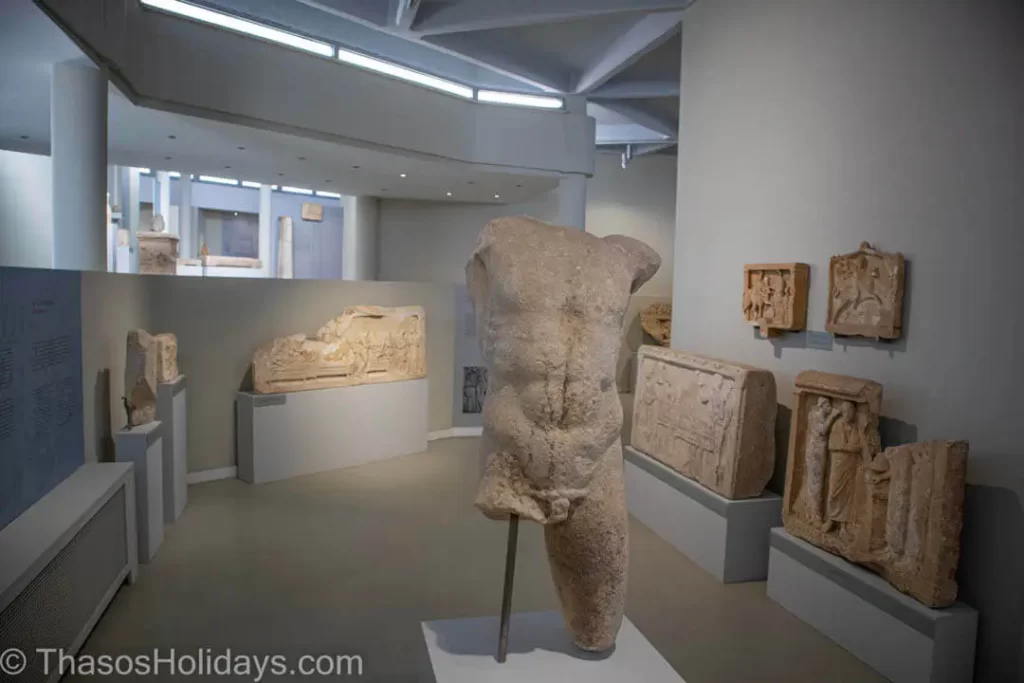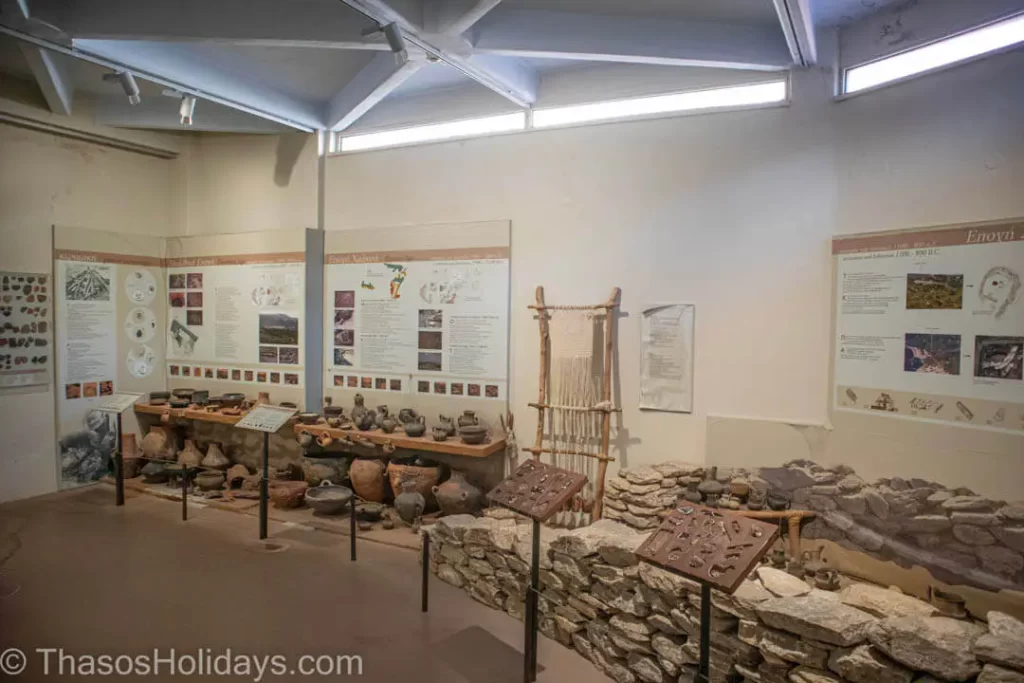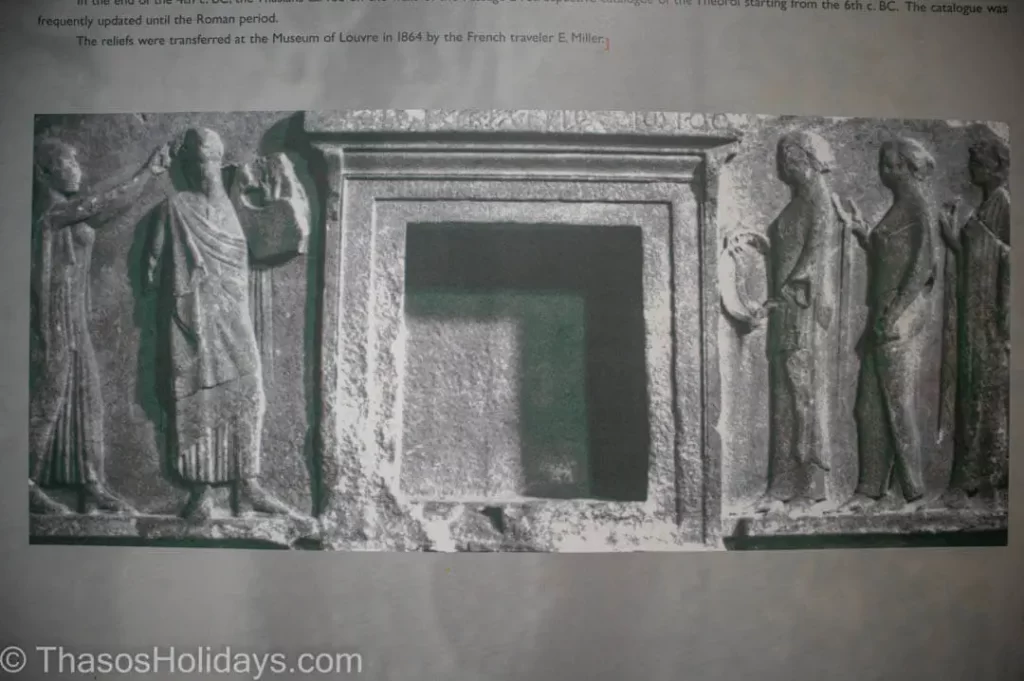Thassos, the beautiful island in Eastern Macedonia, Greece, is not only known for its stunning beaches and crystal-clear waters but also for its rich historical and cultural heritage. One of the must-visit destinations for history enthusiasts is the Archaeological Museum of Thassos, located in the capital city of Limenas, Thassos Town.
This museum offers fascinating insight into the area’s ancient civilization. It showcases various artifacts and treasures from the Neolithic to the Roman period. Join us on a virtual tour as we explore the wonders of this remarkable organized museum.

Stepping into History: The Origins of the Archaeological Museum in Thassos
The Archaeological Museum of Thassos operates in a building that dates back to 1934, in Limenas Thassos Town. Recently renovated and extended, it now features fully operational storerooms, workshops, and exhibition spaces.
As you enter the best archaeological museum in Thassos, you’ll be greeted by an impressive collection of sculptures, pottery, and architectural remains, all meticulously curated to provide a comprehensive overview of Thassos’ ancient past.

Unveiling Ancient Treasures: Highlights of the Archaeological Museum in Thassos
Neolithic Marvels: A Glimpse into Prehistoric Life
The museum’s collection offers a unique opportunity to travel back in time and explore the Neolithic period on Thassos. Among the standout exhibits is a clay amphora from a Neolithic settlement, showcasing the early craftsmanship of Thassos island’s inhabitants.
Another remarkable artifact is a Cycladic plate adorned with a depiction of the hero Bellerophon on the winged Pegasus, engaged in combat with the three-headed Chimaera. Dated back to the 7th century BC, this piece showcases the artistic prowess of the ancient Thassians.

Archaic Splendors: A Testament to Early Greek Artistry in the Archaeological Museum in Thassos
The museum’s collection also covers the Archaic period, with several exceptional sculptures stealing the spotlight. One of the most awe-inspiring pieces is a towering 3.5-meter-tall kouros, a statue of a young naked man carrying a goat.
This masterpiece, discovered in Pythion, captivates visitors with its intricate details and imposing presence. Another remarkable sculpture is the bust of Pegasus, a symbol of grace and power, crafted with meticulous attention to detail.

Classical Elegance: The Golden Age of Greek Art
Thassos flourished in the Classical period, and the museum’s exhibits reflect the artistic achievements of this era. A head of Dionysos, dating back to the 4th century BC, once formed part of a larger-than-life-size statue that adorned the Temple of Dionysos.
The face’s serene expression and harmonious symmetry make this piece a true masterpiece. Additionally, you can can admire a statue of Comedy, a testament to the significance of theater and entertainment in ancient Thassian society.

Hellenistic and Roman Marvels: Embracing Greek and Roman Influences
The museum’s collection reflects the influence of Hellenistic and Roman cultures on Thassos. A statue of a Muse wearing a peplos, originating from the Temple of Dionysos, showcases the artistic achievements of the 3rd century BC.
Delicately carved and exuding grace, this statue offers a glimpse into the reverence for the arts during this period. Another notable piece is a small statue of Aphrodite with a dolphin and a cupid, displaying the craftsmanship of the Hellenistic era.

A Short History of Thassos
To appreciate your visit to the Archaeological Museum of Thassos, getting to know the history of Thassos will go a long way.
Imagine stepping back twenty thousand years, as our predecessors embarked on a quest to gather ocher from the local caves, including the iconic Tzines cave, which remains open for exploration today. During this era, Thassos was not yet an island but a part of the mainland, until a significant earthquake around 10,000BC separated it, marking the birth of an island.
As the Stone Age transitioned into the later years, the first settlements emerged in what we now know as Limenaria and Skala Sotiros, characterized by a vastly different landscape, with the seashore situated farther away.
The advent of the Copper Age brought forth the establishment of additional settlements in Kastri, Ai-Lia in Theologos, Limenas, and various caves across the island. In 680BC, citizens of Paros settled on Thassos, marking a pivotal moment in its history.

The island flourished under the dominance of the Parians, as Thassos evolved into a regional powerhouse, propelled by a formidable fleet and thriving trade routes. However, this prosperity sparked clashes with Athens, resulting in the sinking of the Thassian fleet and the island falling under the protection of Athens.
Following the Athenians, Thassos came under the rule of the Macedonians, a period marred by intense local animosity due to their oppressive governance. However, the arrival of the Romans was viewed as a liberation, leading to a peaceful and prosperous era, with the Thassians considering the Romans as friends and honoring them with monuments.
As the Roman Empire fragmented, Thassos transitioned to Byzantine rule, leading to a decline in its splendor due to frequent invasions and raids by hostile forces and pirates. The island’s trials continued under Ottoman rule, marked by piracy raids and significant migration crises.
Amidst these tumultuous times, the 19th century brought renewed hope for the Thassians, as they sought to unify with the emerging Greek state. Despite initial setbacks and a devastating massacre of 1000 Thassians, the island finally gained its independence in 1913, nearly 500 years after the fall of Constantinople.
If the tale of Thassos sparks your curiosity, delve deeper and explore the island’s history in intricate detail in this ultimate Thassos History Guide!

Archaeological Museum in Thassos Visiting Information: Opening Hours and Ticketing
Before planning your visit to the Archaeological Museum of Thassos, it’s essential to note the museum’s opening hours and admission fees. The museum is typically closed on Tuesdays, and during the winter season (November – March), the opening hours are from 08:30 – 15:30 (09:00 – 16:00 for major museums).
The Archaeological Museum in Thassos opening hours are extended during the summer season (April – October). However, I always recommend checking the official Ministry of Culture and Sports website or contacting the museum directly for any adjustments or changes to the opening hours.
To enter the museum, you need valid Archaeological museum in thassos tickets for both full and reduced admission. It’s worth noting that some museums and archaeological sites offer special ticket packages for visitors interested in exploring multiple attractions within the same area.

If you plan to visit Thassos during specific holidays, it’s essential to know that museums are closed on particular dates. For example, the museum is closed on January 1st, Greek Orthodox Easter Sunday, and December 25th and 26th. And if you are around during Easter, make sure to stop by the Carnival!
However, museums are open on holidays like January 6th, Clean Monday, and October 28th. Additionally, there are certain days throughout the year when admission is free for all visitors, such as International Monuments Day and International Museums Day, or the first Sunday of each month.
Check the museum’s website or contact them directly to ensure the most up-to-date information and confirmations.

Tips and Recommendations on your visit to Archaeological Museum in Thassos
To make your visit to the Archaeological Museum in Limenas Thassos Greece, genuinely memorable, here are some tips and recommendations:
- Plan Ahead: Take the time to research the museum’s collection and familiarize yourself with the highlights. That will allow you to prioritize your visit and fully appreciate the significance of each exhibit.
- Guided Archaeological Museum in Thassos Tours: Consider joining a guided tour to gain deeper insights into the artifacts and their historical context. The knowledgeable guides can provide fascinating stories and anecdotes that bring the ancient Thracian civilization to life.
- Interactive Exhibits: Explore the museum’s interactive exhibits and multimedia displays. These interactive elements provide a hands-on experience and make learning about Thassos’ history an engaging and immersive adventure.
- Cave Paintings: Thassos’s history dates back millennia, and the Archaeological Museum of Thassos will give you a glimpse of these forgotten times.
- Capture the Moment: Remember to bring your camera to capture the beauty of the artifacts and the grandeur of the museum’s architecture. However, please be mindful of any photography restrictions within the museum.
- Explore Further: After you visit the Archaeological Museum, continue your exploration of Thassos by visiting other archaeological sites on the island. Discover the ancient ruins of temples, theaters, and agora, and delve deeper into the rich history that shaped Thassos into its vibrant destination today.

Conclusion: A Journey through Time at the Archaeological Museum of Thassos
The Archaeological Museum of Thassos is a true gem, offering visitors a unique opportunity to delve into the island’s ancient past.
From the Neolithic period to the Roman era, the museum’s collection showcases Thassos’ artistic achievements and cultural significance throughout history. Immerse yourself in the exhibits, marvel at the masterpieces, and let the stories of the past transport you to a bygone era.
Whether you’re a history enthusiast, an art lover, or simply curious about the island’s heritage, a visit to the Archaeological Museum of Thassos is an unforgettable experience that will leave you with a deeper appreciation for the rich tapestry of Thassos’ past.
So, come and embark on a journey through time, where Thassos legends come alive, and the spirit of Thassos awaits your discovery.

Frequently Asked Questions about the Archaeological Museum in Thassos
What can I see at the Archaeological Museum of Thassos?
Discover the island’s history from Prehistoric to Early Christian times. Marvel at the impressive exhibits, including a 3.5-meter archaic Kouros statue.
What are the opening hours for the museum?
During summer (April 1 to October 31), it’s open from 8 am to 8 pm. Winter hours (November 1 to March 31) are 8:30 am to 3:30 pm, and it’s closed on Tuesdays.
How much does it cost to enter the museum?
Tickets are 4€ in summer, 2€ in winter. From November to March, all visitors enjoy a reduced ticket price. Remember, the last entry is 20 minutes before closing.
Are there any free admission days to the museum?
Yes, enjoy free entry on March 6, April 18, May 18, the last weekend in September, October 28, and every first Sunday from November to March.
Is the museum accessible for people with disabilities?
Absolutely! The museum is equipped with ramps, lifts, and tactile materials to accommodate visitors with disabilities.
Does the museum offer educational programs?
Indeed, the museum provides educational programs. It’s a great way to deepen your understanding of Thassos’s ancient heritage.
Can I purchase souvenirs at the museum?
Yes, there’s a Museum Shop on site where you can buy memorabilia related to the island’s archaeological treasures.
How do I contact the Archaeological Museum of Thassos?
You can call them at (+30) 2593022180 or send an email to efakav@culture.gr for any inquiries.
What’s the address of the Archaeological Museum of Thassos?
Find it at 2 M. Alexandrou Str., Port of Thassos, Thassos 64004. It’s conveniently located near the center of Limenas.
Is the museum open during public holidays?
The museum closes on January 1, March 25, Easter Sunday, May 1, and December 25 & 26. But it’s open on several other public holidays.

Insider Info
For even more insider info, check out this complete list of 101 Things to Do on the Island, read my Comprehensive Guide on all Thassos Villages, or get inspiration from these 21 ideas for Day Trips in Thassos!
If you’re convinced you should visit the island, these are the best times to visit Thassos and details on how to get to Thassos! (One of the most special seasons is winter in Thassos!)
Whichever season and time you arrive on the island, make sure to follow these 24 Thassos Travel Tips and avoid the following 20 common Thassos Travel mistakes.
And if you haven’t decided on your holiday itinerary yet, check one of my suggested itineraries for your Thasos holidays: a 7-day itinerary, a 5-day itinerary, or a shorter 4-day itinerary.
And to show off your Thassos holidays on Instagram, visit the 20 most Instagrammable places in Thassos or these 22 off-the-beaten-path Thassos locations.
To look even cooler in your posts, remember to spice up your Instagram or Facebook feed with one of these 106 Captions and Quotes about Thassos or one of the 35 fun facts about Thassos.







0 Comments